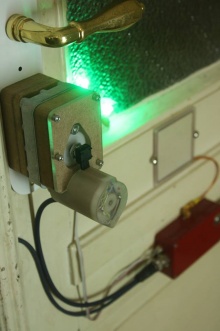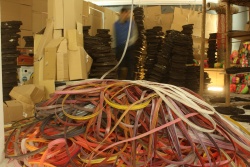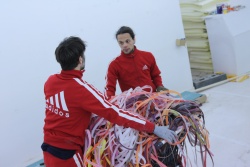YNNOK
| YNNOK Release status: stable [box doku] | |
|---|---|

| |
| Description | NFC Door opening mechanism. |
| Author(s) | A.B. (Bilex) |
| Platform | Sophistication |
Information
YNNOK (You Need NO Key) is an AVR driven RFID door opening device. A small motor is directly attached to the lock and turns a shortened key like a human would do to lock or unlock the door. A 125khz RFID system detects transponders, reads the inner ASCII string and compares it to a list of valid strings. YNNOK is connected to a RS-484 databus to communicate with the local WiFi router. This makes the system accessible with your computer or any handheld device. Since this ability the NFC option is hardly used but still implemented.
Mechanics
The mechanical heart of YNNOK is a low-budget DC gearmotor. It operates with 12V and is connected to a L293D motordriver IC. A small brass adapter with a 2mm groove grabs the key and turns it around. In order to give the AVR information about the position of the key a potentiometer was installed a the backside of the motor. A gear reduction between the motor and the poti shaft increases the operation range of the poti. Due to this trick a common poti can measure more than two total rotations which is important to lock the door twice. The accuracy of this simple feedback system is still satisfying enough to turn the key into three positions by reading the poti with a 10-Bit ADC.
The lock inside the door is old and creepy. Under normal conditions it works fine, but sometimes it stucks. Especially if a user tries to lock the door and pulls it at the same time. To prevent a mechanical damage, the motor current is measured. If the motorcurrent grows above a certain level the motor will turn to its normal position again.
YNNOK was designed with Autodesk Inventor and most parts were manufactured with the DAS-LABOR CNC-Fräse. After a few weeks of operation the open backside of the motor with touchable cables and solder contacts annoyed a few frequent YNNOK users. To make it more safe and to have a proper cable guidance a motorcap was printed with a 3D printer.
The Machine
Motor & Gear & Housing
First tests were made with a low-budget gearmotor found on ebay. Those are advertised with high torque rates. A closer look at the data sheet shows that sometimes these numbers are the stall values. That means: No rotation at given load. The required torque for proper operation was not known before and there was no clue how to calculate it. The motor not only needs to press the material through the pipe and the die, sometimes the drill needs to cut pellets on their way from the hopper inside the heating pipe. That means that the required power depends on the used material. The first test-material was a gift from the plastic lab of the University Duisburg Essen. They gave us a whole 25kg bag for testing purpose. Unfortunately the material was not suitable for processing it in a selfmade-extruder due to its low MFI (Melt-flow-index) value. Even with very high temperatures the material did not become liquid as expected. Even without a die the first testing drivetrain nearly stalled.
After that failure I met Helmut at the Labor. Helmut is a polymere expert. He advised me to try a PE with a higher MFI. He recommended me to contact a well-known local plastic company in order to ask for a helping hand. A few days later another 25kg PE bag with PE pellets inside (amazing: PE pellets packed in a PE bag.) arrived at the Labor. Within these days I found a 120V gearmotor in the Labor basement. Someone told me it was used as mechanical switch in a high voltage application. This means: The device temperature may increase during continuous operation. Finally the motor was operated with 15V and there where no thermal problems at all. Although the motor is very big and seems to be very powerful (no datasheet or further information available) a gear box was added to increase torque by lowering the speed of rotation. The gearbox was manufactured by using the Labor CNC-Fräse. This was the most intense adventure I experienced with the machine so far. Proper gears and a solid housing are important to handle the power of the transmission. According to the power consumption and the speed of rotation the torque is approx. 10Nm during normal operation and using the high MFI LD-PE.
Heating Unit
Die
Shaping Unit
Distribution
Video
Video on Youtube









